Comprehensive Financial Management Report and IFRS Compliance
VerifiedAdded on 2023/06/11
|7
|1346
|89
Report
AI Summary
This financial management report addresses fundamental concepts in the financial services industry, including ethical principles, legislative requirements, and the significance of BAS and ABN. It explains cash flow budgets, essential financial statements, and the impact of depreciation on profitability. The report also examines double-entry bookkeeping and analyzes Wesfarmers' annual report, assessing financial performance, IFRS compliance, and the accuracy of financial reporting. It provides a comprehensive overview of key financial practices and reporting standards, offering valuable insights for stakeholders and students alike. Desklib provides solved assignments and past papers for students.
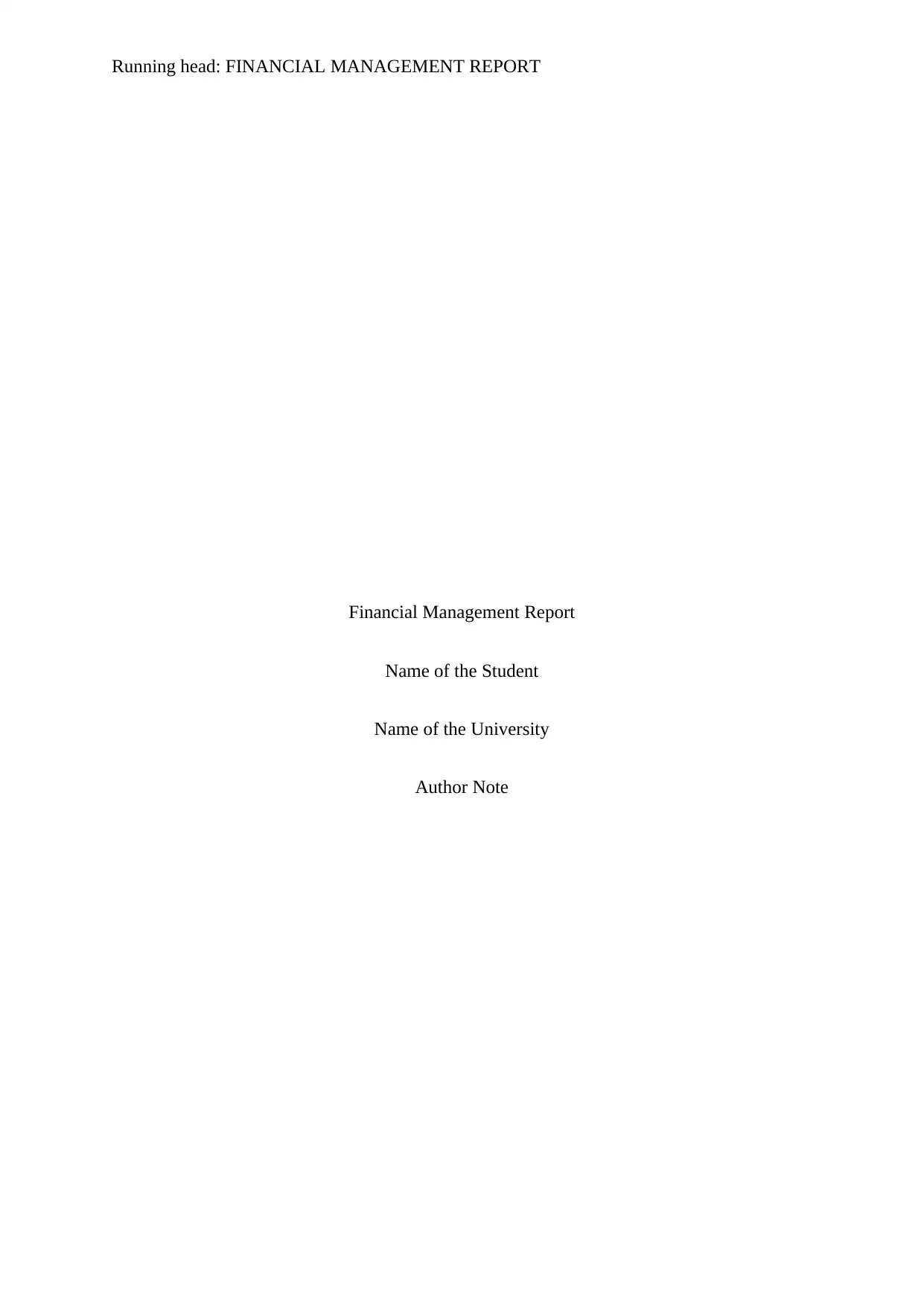
Running head: FINANCIAL MANAGEMENT REPORT
Financial Management Report
Name of the Student
Name of the University
Author Note
Financial Management Report
Name of the Student
Name of the University
Author Note
Paraphrase This Document
Need a fresh take? Get an instant paraphrase of this document with our AI Paraphraser
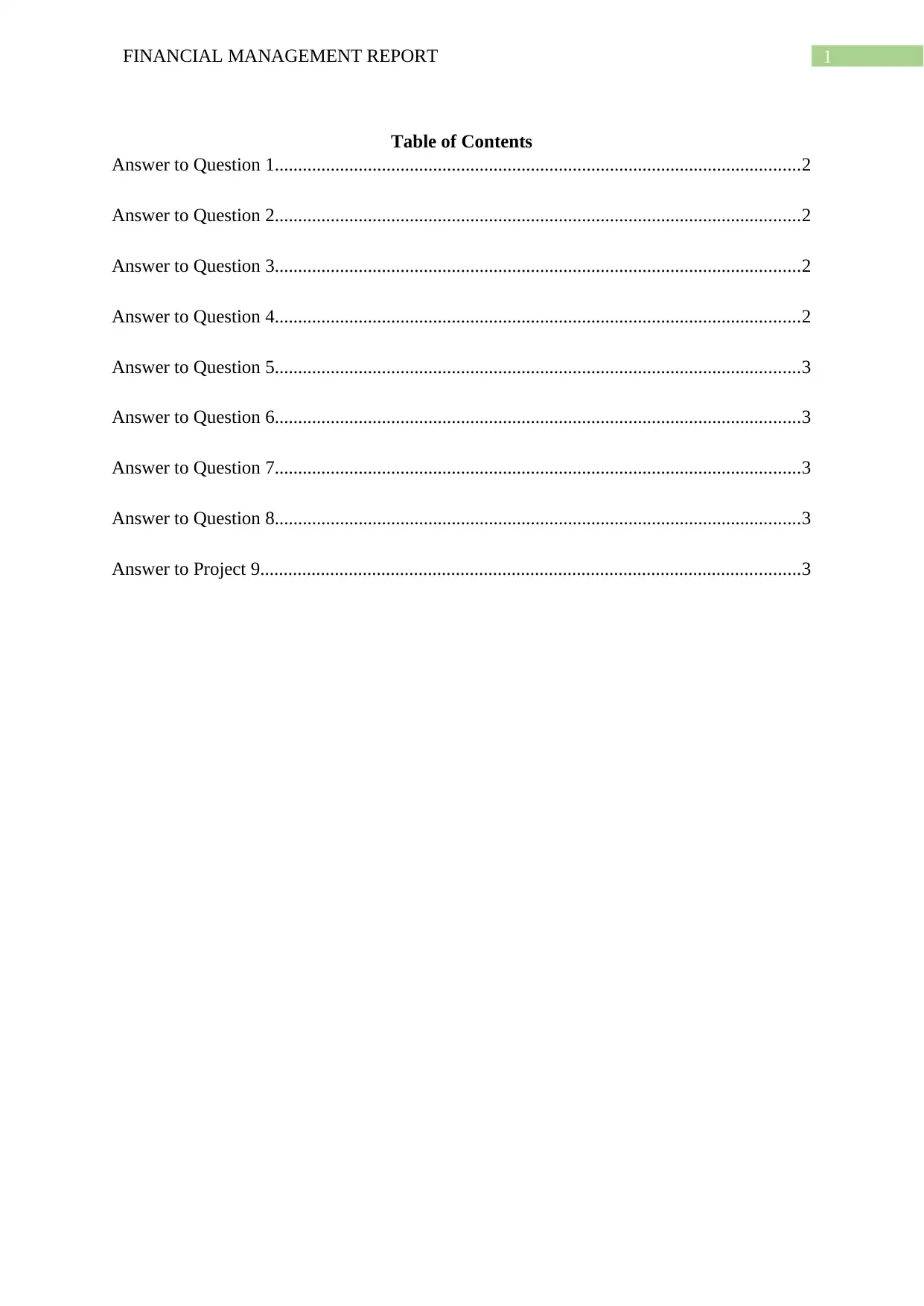
1FINANCIAL MANAGEMENT REPORT
Table of Contents
Answer to Question 1.................................................................................................................2
Answer to Question 2.................................................................................................................2
Answer to Question 3.................................................................................................................2
Answer to Question 4.................................................................................................................2
Answer to Question 5.................................................................................................................3
Answer to Question 6.................................................................................................................3
Answer to Question 7.................................................................................................................3
Answer to Question 8.................................................................................................................3
Answer to Project 9....................................................................................................................3
Table of Contents
Answer to Question 1.................................................................................................................2
Answer to Question 2.................................................................................................................2
Answer to Question 3.................................................................................................................2
Answer to Question 4.................................................................................................................2
Answer to Question 5.................................................................................................................3
Answer to Question 6.................................................................................................................3
Answer to Question 7.................................................................................................................3
Answer to Question 8.................................................................................................................3
Answer to Project 9....................................................................................................................3
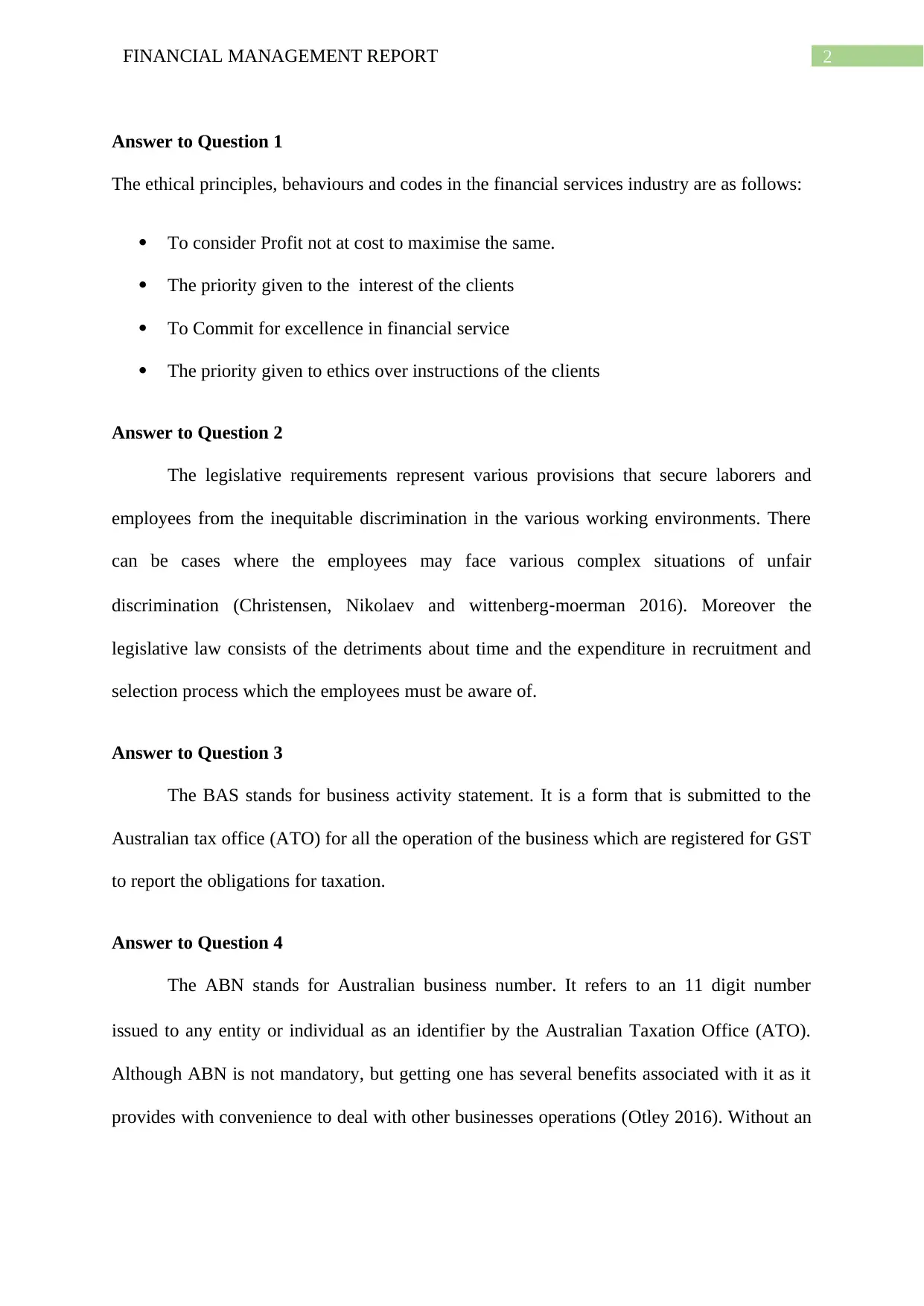
2FINANCIAL MANAGEMENT REPORT
Answer to Question 1
The ethical principles, behaviours and codes in the financial services industry are as follows:
To consider Profit not at cost to maximise the same.
The priority given to the interest of the clients
To Commit for excellence in financial service
The priority given to ethics over instructions of the clients
Answer to Question 2
The legislative requirements represent various provisions that secure laborers and
employees from the inequitable discrimination in the various working environments. There
can be cases where the employees may face various complex situations of unfair
discrimination (Christensen, Nikolaev and wittenberg‐moerman 2016). Moreover the
legislative law consists of the detriments about time and the expenditure in recruitment and
selection process which the employees must be aware of.
Answer to Question 3
The BAS stands for business activity statement. It is a form that is submitted to the
Australian tax office (ATO) for all the operation of the business which are registered for GST
to report the obligations for taxation.
Answer to Question 4
The ABN stands for Australian business number. It refers to an 11 digit number
issued to any entity or individual as an identifier by the Australian Taxation Office (ATO).
Although ABN is not mandatory, but getting one has several benefits associated with it as it
provides with convenience to deal with other businesses operations (Otley 2016). Without an
Answer to Question 1
The ethical principles, behaviours and codes in the financial services industry are as follows:
To consider Profit not at cost to maximise the same.
The priority given to the interest of the clients
To Commit for excellence in financial service
The priority given to ethics over instructions of the clients
Answer to Question 2
The legislative requirements represent various provisions that secure laborers and
employees from the inequitable discrimination in the various working environments. There
can be cases where the employees may face various complex situations of unfair
discrimination (Christensen, Nikolaev and wittenberg‐moerman 2016). Moreover the
legislative law consists of the detriments about time and the expenditure in recruitment and
selection process which the employees must be aware of.
Answer to Question 3
The BAS stands for business activity statement. It is a form that is submitted to the
Australian tax office (ATO) for all the operation of the business which are registered for GST
to report the obligations for taxation.
Answer to Question 4
The ABN stands for Australian business number. It refers to an 11 digit number
issued to any entity or individual as an identifier by the Australian Taxation Office (ATO).
Although ABN is not mandatory, but getting one has several benefits associated with it as it
provides with convenience to deal with other businesses operations (Otley 2016). Without an
⊘ This is a preview!⊘
Do you want full access?
Subscribe today to unlock all pages.

Trusted by 1+ million students worldwide
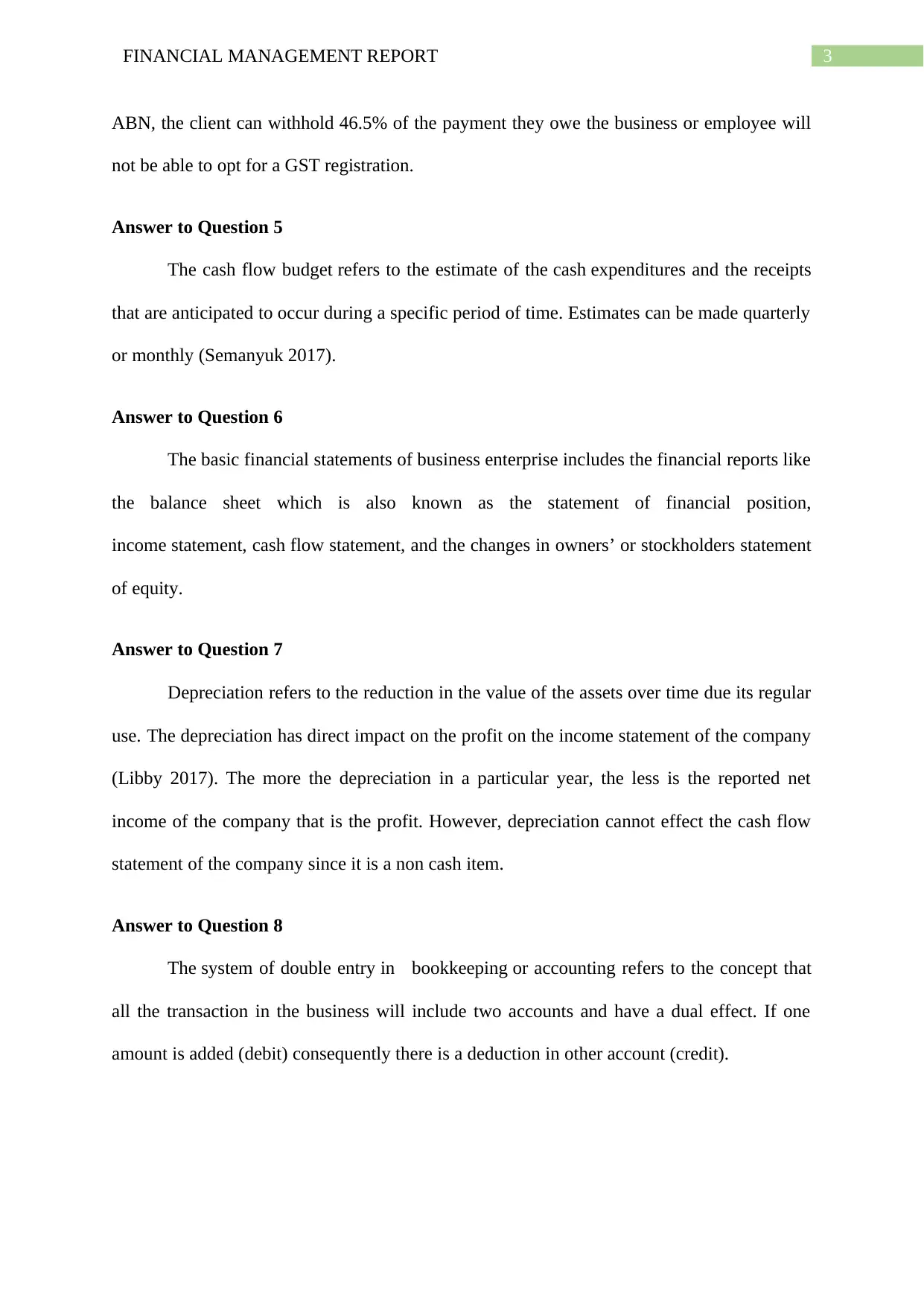
3FINANCIAL MANAGEMENT REPORT
ABN, the client can withhold 46.5% of the payment they owe the business or employee will
not be able to opt for a GST registration.
Answer to Question 5
The cash flow budget refers to the estimate of the cash expenditures and the receipts
that are anticipated to occur during a specific period of time. Estimates can be made quarterly
or monthly (Semanyuk 2017).
Answer to Question 6
The basic financial statements of business enterprise includes the financial reports like
the balance sheet which is also known as the statement of financial position,
income statement, cash flow statement, and the changes in owners’ or stockholders statement
of equity.
Answer to Question 7
Depreciation refers to the reduction in the value of the assets over time due its regular
use. The depreciation has direct impact on the profit on the income statement of the company
(Libby 2017). The more the depreciation in a particular year, the less is the reported net
income of the company that is the profit. However, depreciation cannot effect the cash flow
statement of the company since it is a non cash item.
Answer to Question 8
The system of double entry in bookkeeping or accounting refers to the concept that
all the transaction in the business will include two accounts and have a dual effect. If one
amount is added (debit) consequently there is a deduction in other account (credit).
ABN, the client can withhold 46.5% of the payment they owe the business or employee will
not be able to opt for a GST registration.
Answer to Question 5
The cash flow budget refers to the estimate of the cash expenditures and the receipts
that are anticipated to occur during a specific period of time. Estimates can be made quarterly
or monthly (Semanyuk 2017).
Answer to Question 6
The basic financial statements of business enterprise includes the financial reports like
the balance sheet which is also known as the statement of financial position,
income statement, cash flow statement, and the changes in owners’ or stockholders statement
of equity.
Answer to Question 7
Depreciation refers to the reduction in the value of the assets over time due its regular
use. The depreciation has direct impact on the profit on the income statement of the company
(Libby 2017). The more the depreciation in a particular year, the less is the reported net
income of the company that is the profit. However, depreciation cannot effect the cash flow
statement of the company since it is a non cash item.
Answer to Question 8
The system of double entry in bookkeeping or accounting refers to the concept that
all the transaction in the business will include two accounts and have a dual effect. If one
amount is added (debit) consequently there is a deduction in other account (credit).
Paraphrase This Document
Need a fresh take? Get an instant paraphrase of this document with our AI Paraphraser
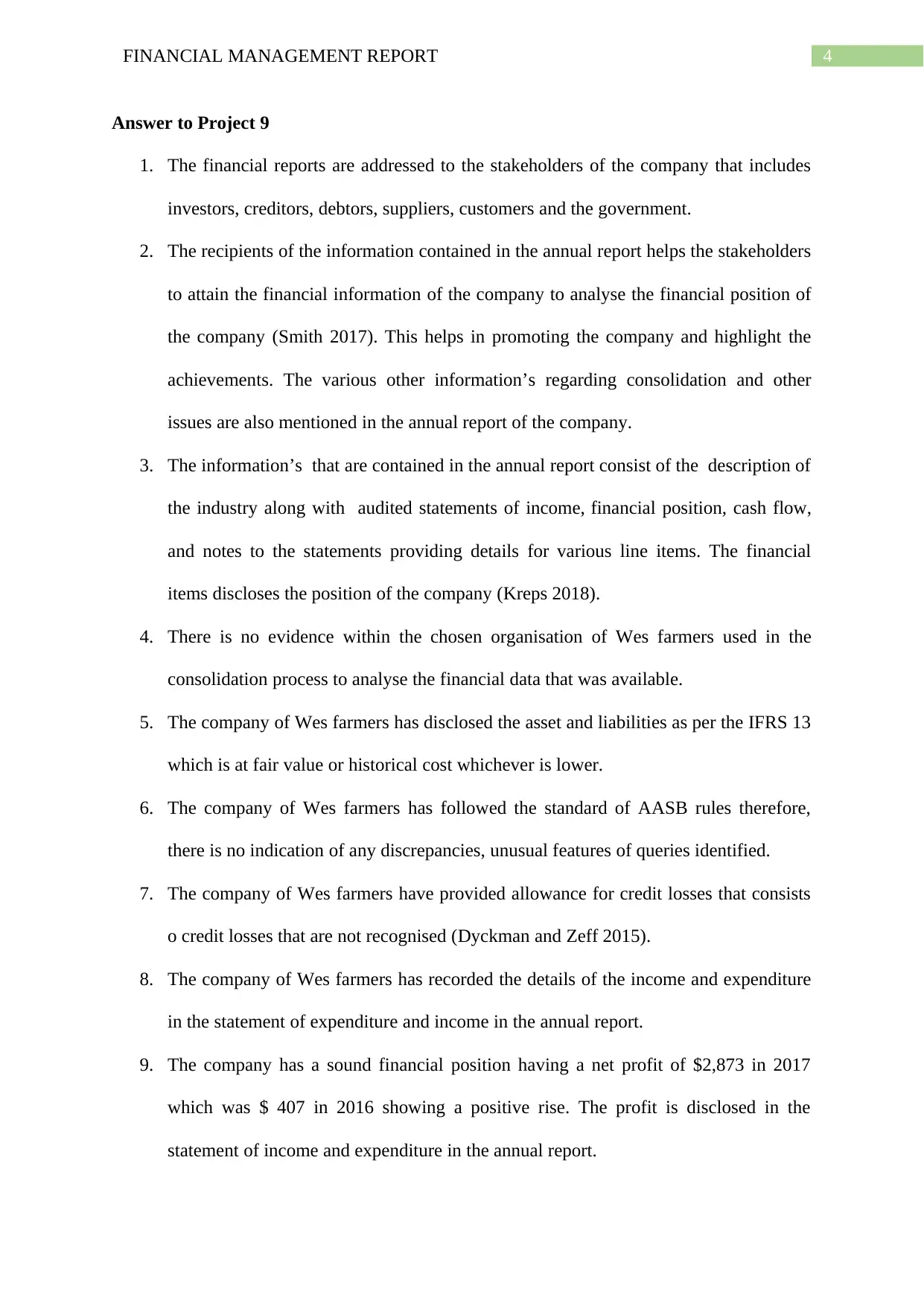
4FINANCIAL MANAGEMENT REPORT
Answer to Project 9
1. The financial reports are addressed to the stakeholders of the company that includes
investors, creditors, debtors, suppliers, customers and the government.
2. The recipients of the information contained in the annual report helps the stakeholders
to attain the financial information of the company to analyse the financial position of
the company (Smith 2017). This helps in promoting the company and highlight the
achievements. The various other information’s regarding consolidation and other
issues are also mentioned in the annual report of the company.
3. The information’s that are contained in the annual report consist of the description of
the industry along with audited statements of income, financial position, cash flow,
and notes to the statements providing details for various line items. The financial
items discloses the position of the company (Kreps 2018).
4. There is no evidence within the chosen organisation of Wes farmers used in the
consolidation process to analyse the financial data that was available.
5. The company of Wes farmers has disclosed the asset and liabilities as per the IFRS 13
which is at fair value or historical cost whichever is lower.
6. The company of Wes farmers has followed the standard of AASB rules therefore,
there is no indication of any discrepancies, unusual features of queries identified.
7. The company of Wes farmers have provided allowance for credit losses that consists
o credit losses that are not recognised (Dyckman and Zeff 2015).
8. The company of Wes farmers has recorded the details of the income and expenditure
in the statement of expenditure and income in the annual report.
9. The company has a sound financial position having a net profit of $2,873 in 2017
which was $ 407 in 2016 showing a positive rise. The profit is disclosed in the
statement of income and expenditure in the annual report.
Answer to Project 9
1. The financial reports are addressed to the stakeholders of the company that includes
investors, creditors, debtors, suppliers, customers and the government.
2. The recipients of the information contained in the annual report helps the stakeholders
to attain the financial information of the company to analyse the financial position of
the company (Smith 2017). This helps in promoting the company and highlight the
achievements. The various other information’s regarding consolidation and other
issues are also mentioned in the annual report of the company.
3. The information’s that are contained in the annual report consist of the description of
the industry along with audited statements of income, financial position, cash flow,
and notes to the statements providing details for various line items. The financial
items discloses the position of the company (Kreps 2018).
4. There is no evidence within the chosen organisation of Wes farmers used in the
consolidation process to analyse the financial data that was available.
5. The company of Wes farmers has disclosed the asset and liabilities as per the IFRS 13
which is at fair value or historical cost whichever is lower.
6. The company of Wes farmers has followed the standard of AASB rules therefore,
there is no indication of any discrepancies, unusual features of queries identified.
7. The company of Wes farmers have provided allowance for credit losses that consists
o credit losses that are not recognised (Dyckman and Zeff 2015).
8. The company of Wes farmers has recorded the details of the income and expenditure
in the statement of expenditure and income in the annual report.
9. The company has a sound financial position having a net profit of $2,873 in 2017
which was $ 407 in 2016 showing a positive rise. The profit is disclosed in the
statement of income and expenditure in the annual report.
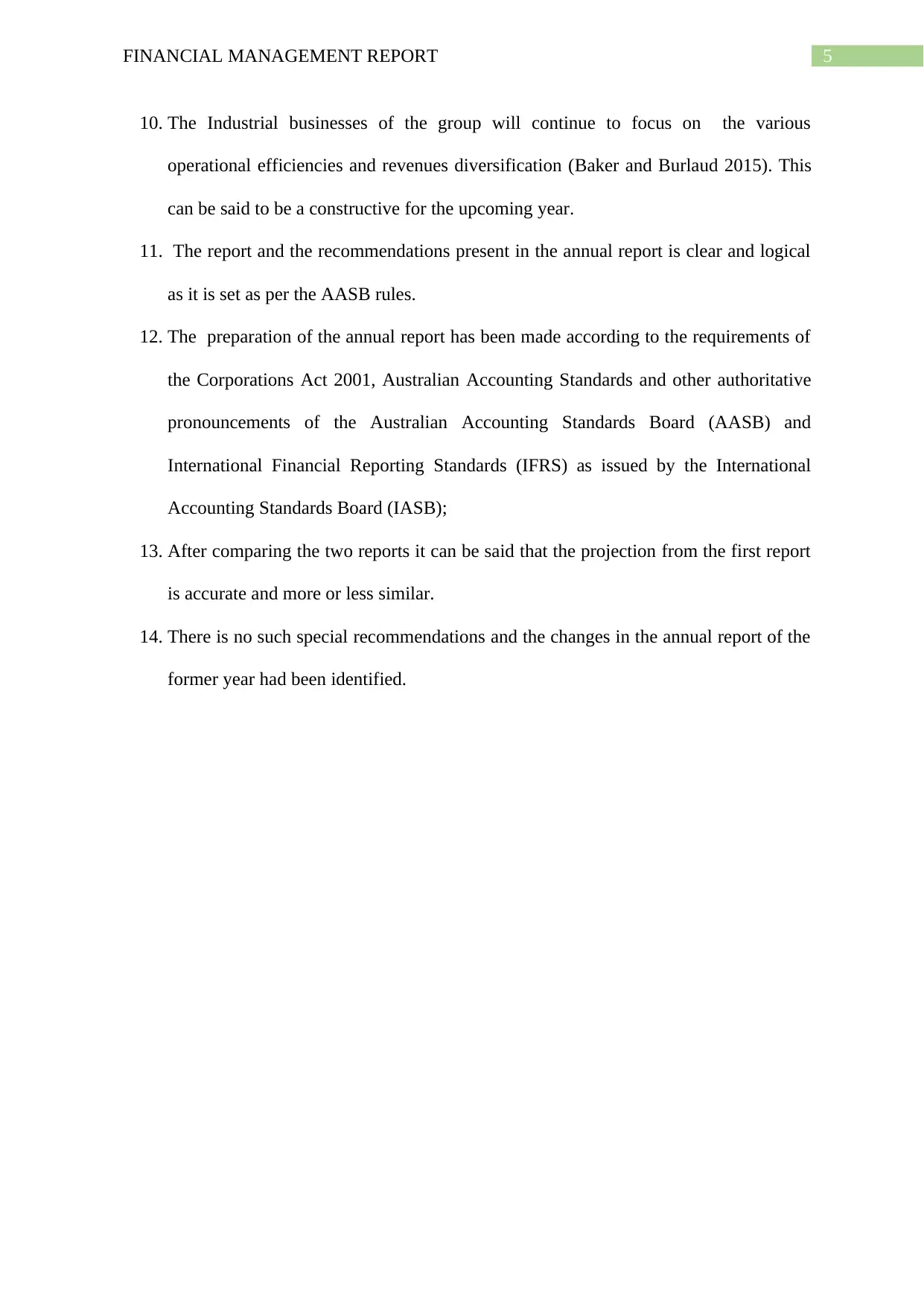
5FINANCIAL MANAGEMENT REPORT
10. The Industrial businesses of the group will continue to focus on the various
operational efficiencies and revenues diversification (Baker and Burlaud 2015). This
can be said to be a constructive for the upcoming year.
11. The report and the recommendations present in the annual report is clear and logical
as it is set as per the AASB rules.
12. The preparation of the annual report has been made according to the requirements of
the Corporations Act 2001, Australian Accounting Standards and other authoritative
pronouncements of the Australian Accounting Standards Board (AASB) and
International Financial Reporting Standards (IFRS) as issued by the International
Accounting Standards Board (IASB);
13. After comparing the two reports it can be said that the projection from the first report
is accurate and more or less similar.
14. There is no such special recommendations and the changes in the annual report of the
former year had been identified.
10. The Industrial businesses of the group will continue to focus on the various
operational efficiencies and revenues diversification (Baker and Burlaud 2015). This
can be said to be a constructive for the upcoming year.
11. The report and the recommendations present in the annual report is clear and logical
as it is set as per the AASB rules.
12. The preparation of the annual report has been made according to the requirements of
the Corporations Act 2001, Australian Accounting Standards and other authoritative
pronouncements of the Australian Accounting Standards Board (AASB) and
International Financial Reporting Standards (IFRS) as issued by the International
Accounting Standards Board (IASB);
13. After comparing the two reports it can be said that the projection from the first report
is accurate and more or less similar.
14. There is no such special recommendations and the changes in the annual report of the
former year had been identified.
⊘ This is a preview!⊘
Do you want full access?
Subscribe today to unlock all pages.

Trusted by 1+ million students worldwide
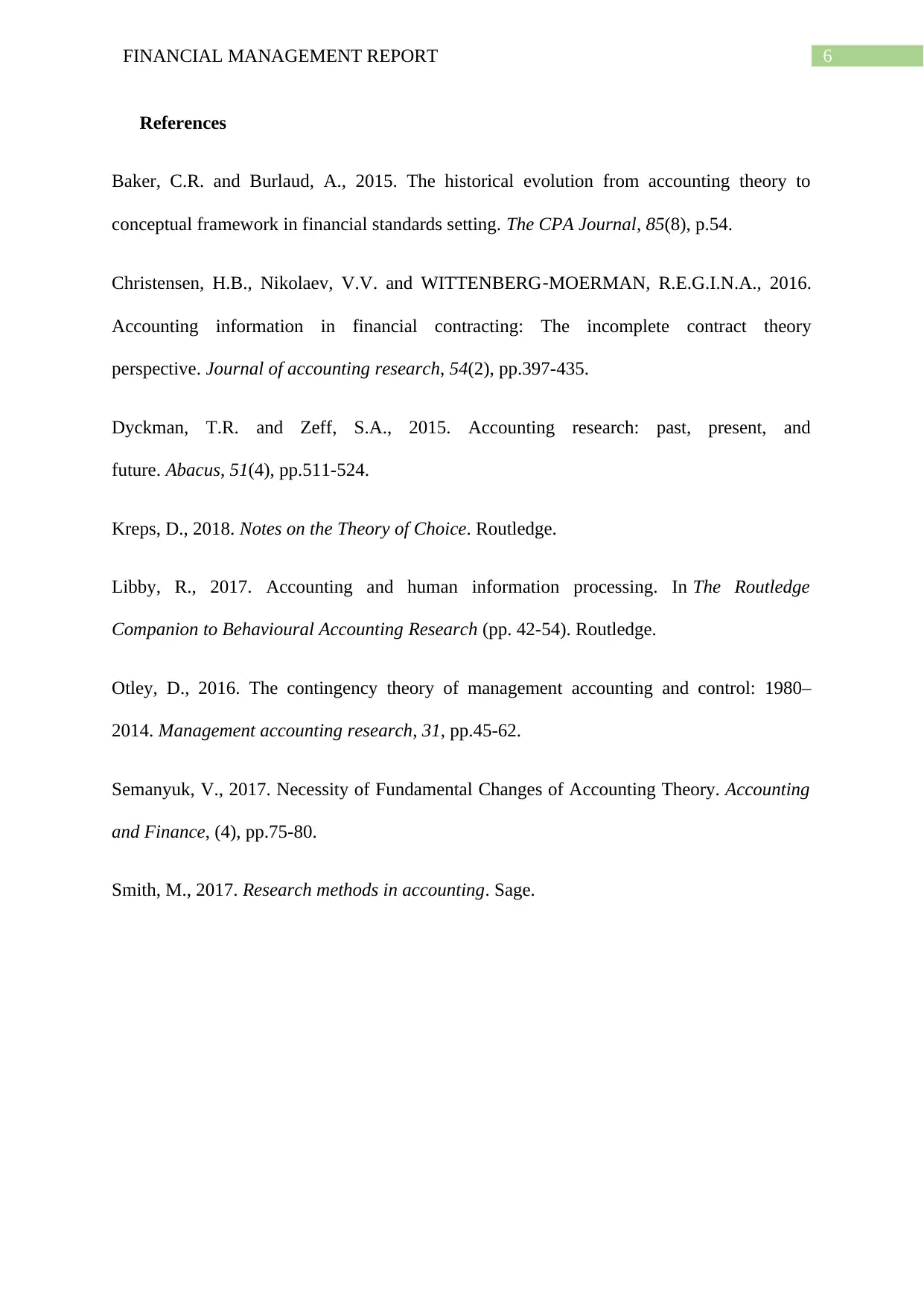
6FINANCIAL MANAGEMENT REPORT
References
Baker, C.R. and Burlaud, A., 2015. The historical evolution from accounting theory to
conceptual framework in financial standards setting. The CPA Journal, 85(8), p.54.
Christensen, H.B., Nikolaev, V.V. and WITTENBERG‐MOERMAN, R.E.G.I.N.A., 2016.
Accounting information in financial contracting: The incomplete contract theory
perspective. Journal of accounting research, 54(2), pp.397-435.
Dyckman, T.R. and Zeff, S.A., 2015. Accounting research: past, present, and
future. Abacus, 51(4), pp.511-524.
Kreps, D., 2018. Notes on the Theory of Choice. Routledge.
Libby, R., 2017. Accounting and human information processing. In The Routledge
Companion to Behavioural Accounting Research (pp. 42-54). Routledge.
Otley, D., 2016. The contingency theory of management accounting and control: 1980–
2014. Management accounting research, 31, pp.45-62.
Semanyuk, V., 2017. Necessity of Fundamental Changes of Accounting Theory. Accounting
and Finance, (4), pp.75-80.
Smith, M., 2017. Research methods in accounting. Sage.
References
Baker, C.R. and Burlaud, A., 2015. The historical evolution from accounting theory to
conceptual framework in financial standards setting. The CPA Journal, 85(8), p.54.
Christensen, H.B., Nikolaev, V.V. and WITTENBERG‐MOERMAN, R.E.G.I.N.A., 2016.
Accounting information in financial contracting: The incomplete contract theory
perspective. Journal of accounting research, 54(2), pp.397-435.
Dyckman, T.R. and Zeff, S.A., 2015. Accounting research: past, present, and
future. Abacus, 51(4), pp.511-524.
Kreps, D., 2018. Notes on the Theory of Choice. Routledge.
Libby, R., 2017. Accounting and human information processing. In The Routledge
Companion to Behavioural Accounting Research (pp. 42-54). Routledge.
Otley, D., 2016. The contingency theory of management accounting and control: 1980–
2014. Management accounting research, 31, pp.45-62.
Semanyuk, V., 2017. Necessity of Fundamental Changes of Accounting Theory. Accounting
and Finance, (4), pp.75-80.
Smith, M., 2017. Research methods in accounting. Sage.
1 out of 7
Related Documents
Your All-in-One AI-Powered Toolkit for Academic Success.
+13062052269
info@desklib.com
Available 24*7 on WhatsApp / Email
![[object Object]](/_next/static/media/star-bottom.7253800d.svg)
Unlock your academic potential
Copyright © 2020–2025 A2Z Services. All Rights Reserved. Developed and managed by ZUCOL.


